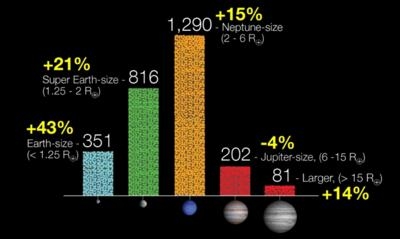Four In Their Sun's 'Habitable Zone'
NASA's Kepler mission announced Monday that the spacecraft has discovered 461 new planet candidates. Four of the potential new planets are less than twice the size of Earth and orbit in their sun's "habitable zone," the region in the planetary system where liquid water might exist on the surface of a planet.

Based on observations conducted from May 2009 to March 2011, the findings show a steady increase in the number of smaller-size planet candidates and the number of stars with more than one candidate. "There is no better way to kickoff the start of the Kepler extended mission than to discover more possible outposts on the frontier of potentially life bearing worlds," said Christopher Burke, Kepler scientist at the SETI Institute in Mountain View, Calif., who is leading the analysis.
Since the last Kepler catalog was released in February 2012, the number of candidates discovered in the Kepler data has increased by 20 percent and now totals 2,740 potential planets orbiting 2,036 stars. The most dramatic increases are seen in the number of Earth-size and super Earth-size candidates discovered, which grew by 43 and 21 percent respectively.
The new data increases the number of stars discovered to have more than one planet candidate from 365 to 467. Today, 43 percent of Kepler's planet candidates are observed to have neighbor planets. "The large number of multi-candidate systems being found by Kepler implies that a substantial fraction of exoplanets reside in flat multi-planet systems," said Jack Lissauer, planetary scientist at NASA's Ames Research Center in Moffett Field, Calif. "This is consistent with what we know about our own planetary neighborhood."
The Kepler space telescope identifies planet candidates by repeatedly measuring the change in brightness of more than 150,000 stars in search of planets that pass in front, or "transit," their host star. At least three transits are required to verify a signal as a potential planet. Scientists analyzed more than 13,000 transit-like signals to eliminate known spacecraft instrumentation and astrophysical false positives, phenomena that masquerade as planetary candidates, to identify the potential new planets.

Candidates require additional follow-up observations and analyses to be confirmed as planets. At the beginning of 2012, 33 candidates in the Kepler data had been confirmed as planets. Today, there are 105. "The analysis of increasingly longer time periods of Kepler data uncovers smaller planets in longer period orbits-- orbital periods similar to Earth's," said Steve Howell, Kepler mission project scientist at Ames. "It is no longer a question of will we find a true Earth analogue, but a question of when."
The complete list of Kepler planet candidates is available in an interactive table at the NASA Exoplanet Archive. The archive is funded by NASA's Exoplanet Exploration Program to collect and make public data to support the search for and characterization of exoplanets and their host stars.
Meanwhile, William Borucki, science principal investigator for NASA's Kepler mission at the agency's Ames Research Center at Moffett Field in California, is the recipient of the 2013 Henry Draper Medal awarded by the National Academy of Sciences. Borucki is honored for his founding concept and visionary leadership during the development of Kepler, which uses transit photometry to determine the frequency and kinds of planets around other stars.
"This is a commendable recognition for Bill Borucki and the Kepler mission," said John Grunsfeld, associate administrator for the Science Mission Directorate at NASA Headquarters in Washington. "It is well deserved and a tribute both to Bill's dedication and persistence and the fantastic and exciting results from Kepler."
 ANN's Daily Aero-Term (04.25.24): Airport Rotating Beacon
ANN's Daily Aero-Term (04.25.24): Airport Rotating Beacon ANN's Daily Aero-Linx (04.25.24)
ANN's Daily Aero-Linx (04.25.24) Klyde Morris (04.22.24)
Klyde Morris (04.22.24) Airborne 04.24.24: INTEGRAL E, Elixir USA, M700 RVSM
Airborne 04.24.24: INTEGRAL E, Elixir USA, M700 RVSM Airborne 04.22.24: Rotor X Worsens, Airport Fees 4 FNB?, USMC Drone Pilot
Airborne 04.22.24: Rotor X Worsens, Airport Fees 4 FNB?, USMC Drone Pilot




